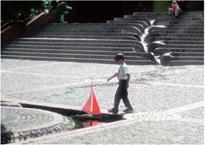|
basins. Herbert Dreiseitl had the basins cut to the millimetre from granite blocks, after developing and testing the movement of the water in his studio in clay and plaster models on a scale of 1:1. The slightest departure from the ideal form would mean that the water would not run as wished in its figure-of – eight pattern based on John Wilkes’ flow principle, which is intended to be reminiscent of a human pulse.
From the lowest step, the water falls on to the granite paving of the marketplace, runs under two five-metre squares and then reappears in brick basins.
It then becomes a plaything, with a straight brick edge on the market place side and a curved one on the catering side, broken up with blocks of stone.
Here the water plunges under the paving again to re-emerge at the end of the pedestrian area in a planted pool. There it is cleaned and taken through an open ford into a pond on the edge of the park. It then runs underground to a tank, and is pumped back up to the source on the town hall steps. A way from the town hall to the park has become a way of taking people to water.
|
![]()



![]()
![]()
![]()

![]()



![]()
![]()
![]()
